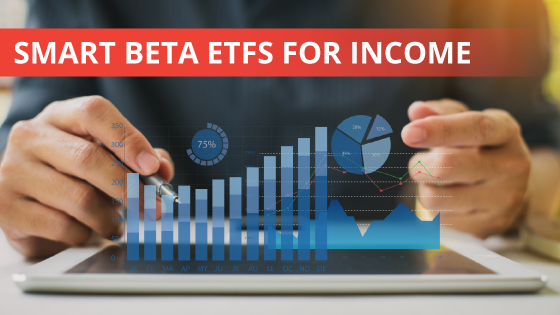The finance world is filled with jargon and buzzwords. If you invest in exchange-traded funds, or ETFs, you’ve probably come across the term “smart beta”. While the “beta” coefficient is a measure of volatility, “smart beta” is an unrelated term used to represent strategies that weight a portfolio by something other than market capitalization.
Most stock funds are weighted by market capitalization, or market cap, which is the total value of a company. This ensures that investors own more of the largest companies. In debt markets, it doesn’t make much sense for investors to own more of the most indebted companies, but that’s what typically happens. Smart beta income funds could provide a better way to weight the debt portion of their portfolios.
Let’s take a look at five smart beta income funds and whether you should incorporate them into your portfolio, along with some alternatives to consider.
What Is Smart Beta?
Most investment strategies are categorized as either active or passive. Exchange-traded funds, or ETFs, are typically “passive” because they track the returns of an underlying market index whereas mutual funds and hedge funds are typically “active” because an asset manager decides when to buy or sell specific securities within a portfolio.
Smart beta funds operate between “active” and “passive” strategies. Rather than weighting a portfolio by market capitalization—as most “passive” ETFs do—they use characteristics, called “factors”, to make capital allocation decisions. These factors might include attributes, like balance sheet strength or stable cash flow, that tend to influence performance and risk.
Interest in Smart Beta Funds on the Rise – Source: Raconteur
For income investors, smart beta funds seek to optimize yields while taking into account credit quality and other risk factors. The bond market is notoriously opaque when it comes to many of these factors, which has made these funds attractive for individual and institutional investors alike that are looking for higher quality yield.
#1. Invesco Fundamental High Yield Corporate Bond ETF (PHB)
The Invesco Fundamental High Yield Corporate Bond ETF (PHB) uses a patented fundamental weighting scheme to select quality high-yield bonds. Compared to other high-yield bonds, the fund offers a higher average yield and lower average maturity. The downside is that the fund has higher interest rate sensitivity.
Fund Characteristics
| Expense Ratio: | 0.50% | Fund Assets (AUM): | $784M |
#2. Vident Core U.S. Bond Strategy ETF (VBND)
The Vident Core U.S. Bond Strategy ETF (VBND) uses a complex multi-factor selection and weighting scheme that includes relative valuation, sector default rates and macro factors to select investment-grade (e.g., core) U.S. bonds. On average, the fund holds bonds with a three-to-seven-year duration, which may appeal to some investors.
Fund Characteristics
| Expense Ratio: | 0.39% | Fund Assets (AUM): | $393M |
#3. Invesco Emerging Markets Sovereign Debt ETF (PCY)
The Invesco Emerging Markets Sovereign Debt ETF (PCY) uses a combination of liquidity and relative value screens to invest in USD-denominated emerging market sovereign debt that has at least three years until maturity. While the fund has geographic diversity, it favors longer maturities than other emerging market funds, creating greater interest rate risk.
Fund Characteristics
| Expense Ratio: | 0.5% | Fund Assets (AUM): | $2.88B |
#4. Van Eck Fallen Angel High Yield Bond ETF (ANGL)
The Van Eck Fallen Angel High Yield Bond ETF (ANGL) uses a value-focused approach to target “fallen angels” in the high yield space. With a focus on recent credit downgrades, the fund aims to identify companies that it believes will experience future credit upgrades and see a compression in credit spreads—a precursor to price appreciation.
Fund Characteristics
| Expense Ratio: | 0.35% | Fund Assets (AUM): | $4.15B |
#5. WisdomTree Fundamental U.S. Corporate Bond ETF (WFIG)
The WisdomTree Fundamental U.S. Corporate Bond ETF (WFIG) uses a value-based approach to select investment-grade U.S. corporate bonds. For example, the fund looks at free cash flows over debt service, leverage ratios and return on invested capital along with the probability of default and duration with a preference toward higher risk-adjusted income.
Fund Characteristics
| Expense Ratio: | 0.18% | Fund Assets (AUM): | $55.05M |
Alternatives to Consider
Fixed income investments are just one way that investors can generate an income from their invested capital. While they certainly play a role in any diversified portfolio, investors shouldn’t neglect the many other ways to generate income—especially during low interest rate environments where bonds may have limited income and upside potential.
Some popular income strategies include:
- Dividend stocks pay out a portion of their earnings as a dividend each quarter.
- Preferred stock is a hybrid between a stock and bond that typically offers a higher dividend (and less risk) than common stock.
- Selling options provide a way for investors to generate an income through premium payments in exchange for entering into certain agreements.
- Alternative investments, such as eREIT or DeFi, enable investors to generate yield from renting real estate, lending money or other activities.
Snider Advisors specializes in helping investors generate an income through covered call options. While holding a portfolio of stocks, investors can generate an income by selling the right to purchase stock that they own. The Snider Investment Method details how to select stocks optimal for covered calls and generating a monthly paycheck from your portfolio.
Sign up for Snider Advisors’ free e-courses or inquire about our asset management services.
The Bottom Line
Smart beta strategies operate in the middle ground between “active” and “passive” funds by using “factors” to quantitatively weight a portfolio. In fixed income, smart beta funds may be able to help investors weight portfolios based on credit risk and other factors rather than relying on market capitalization—a factor that doesn’t make much sense in debt markets.







